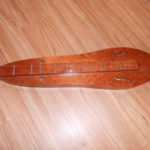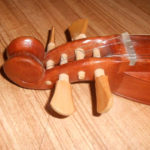Maxwell “Teardrop”
John L Maxwell (1922 – 1981) built around 2300 dulcimers from the mid-60s until the late 70s, many sold from his Upper Cumberland Craft Center in Cookeville, Tennessee. Maxwell was a cabinetmaker who apparently became fascinated by the dulcimer when he saw one at a craft fair in N Carolina in 1964. His dulcimers were popular during this period, being displayed at Gracelands and the Grand Ol’ Opry, as well as being presented to then-president Richard Nixon. Maxwell encouraged apprenticeships in his workshop, but it is not clear whether they were involved in dulcimer making proper or just finishing.
The distinctive shape derives from dulcimers he studied or collected in the Southern Appalachians – a twin-faceted version of the N Carolina teardrop. It is made entirely of cherry, with the exception of the paddle-shaped beech tuning pegs. The back is a single sheet of cherry (i.e. not bookmatched). The unusually wide (1¾”) fingerboard is a single piece of wood, hollowed out underneath, with the (non-bookmatched) top panels tacked on each side. The neat scroll open-box headstock is deliberately left with its carving marks to further its rustic appeal. It has short f-shaped soundholes on the “lower bout” and diamonds on the “upper bout”. Top and back are fiddle-edged. Hard plastic nut and bridge, the latter being only a very short distance from the high tailpiece which acts also as the string anchor for ball end strings (cp Ledford). The woodworking is good but not outstanding. Overall length 32¾”, “upper bout” 4⅝”, “lower bout” 7″, FBW 1¾”, body depth 1¾”, VSL 26½” (medium scale), weight 1lb 16oz (898g). No 6½ fret.
This is a historic and attractive instrument, but its handcut pegs and rustic intonation are not for beginners. For those interested in the development and history of the dulcimer, however, this is an important instrument with a strong and transparent sound, particularly when played noter-style.


